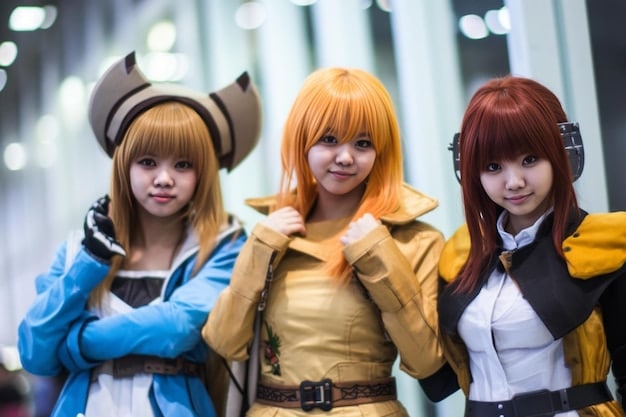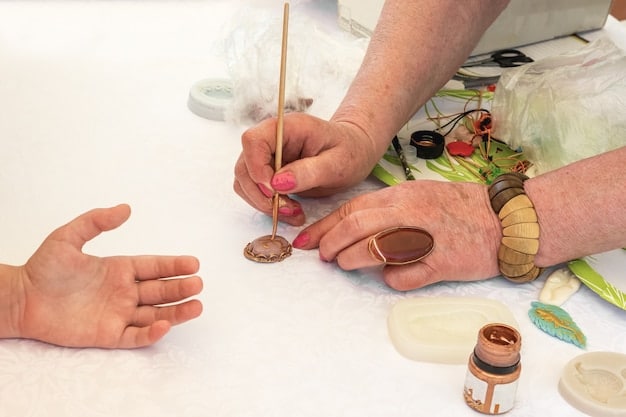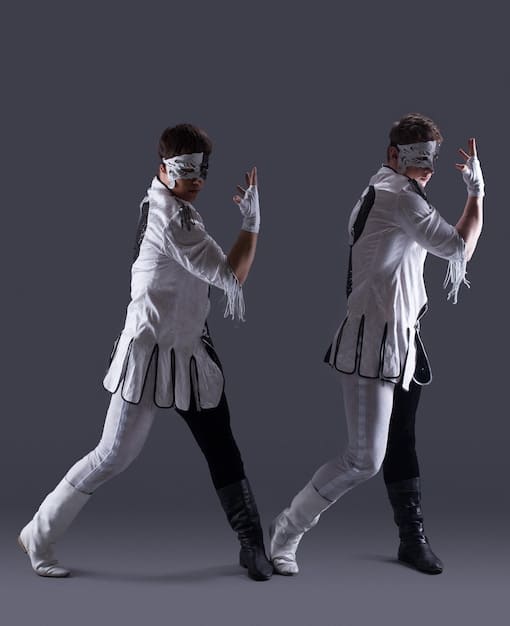Cosplay: Unleash Your Inner Hero (or Villain!)

Cosplay, short for “costume play,” is a vibrant subculture where enthusiasts create and wear costumes to embody characters from various forms of fiction.
Ever dreamed of stepping into the shoes of your favorite superhero or villain? Cosplay offers a unique way to express your creativity, connect with fellow fans, and bring fictional worlds to life. It’s more than just dressing up; it’s an art form, a community, and a whole lot of fun!
What is Cosplay? A Deep Dive into Costume Play
Cosplay, at its core, is the act of dressing up as a character from a pre-existing intellectual property. But it’s so much more than a simple costume. It involves crafting, performing, and embodying the essence of the character you’re portraying. From comic books heroes to anime fighters, the possibilities are endless.
Cosplay goes beyond simply wearing a costume. It’s about inhabiting the character, understanding their motivations, and bringing them to life through performance and interaction. Whether participating in a convention, posting photos online, or just having fun with friends, cosplay is a deeply engaging and creative hobby.
The History of Cosplay
The origins of cosplay can be traced back to science fiction conventions in the United States during the late 1930s. However, it wasn’t until the 1980s that cosplay truly took off as a global phenomenon, thanks to the rise of anime and manga.
The term “cosplay” itself was coined in Japan by Nobuyuki Takahashi in 1984, after attending a science fiction convention in Los Angeles. He used the term to describe the costumed fans he saw, and it quickly caught on in Japan and around the world.
The Appeal of Cosplay
Why do people cosplay? The reasons are as diverse as the characters they portray. For some, it’s a creative outlet, a chance to showcase their crafting skills and attention to detail. For others, it’s a way to connect with their favorite characters on a deeper level, to understand their struggles and celebrate their triumphs.
Cosplay also offers a sense of community. Cosplayers often form groups based on shared interests, attending conventions and events together, supporting each other’s creations, and forming lasting friendships. It’s a welcoming and inclusive community where everyone can find their place.
- Expressing Creativity: Cosplay allows individuals to express their artistic talents through costume design and performance.
- Connecting with Fandoms: It provides a way to engage with favorite stories and characters more deeply.
- Building Community: Cosplay fosters a sense of belonging among like-minded individuals.
- Developing Skills: Cosplayers often learn new skills in crafting, sewing, and prop-making.
In conclusion, cosplay is a multifaceted hobby that blends creativity, fandom, and community. It allows individuals to step into the roles of their favorite characters, expressing themselves artistically and forging connections with others who share their passions.
Crafting Your Cosplay: From Concept to Completion

Creating a cosplay can be a challenging but rewarding process. It requires planning, skill, and attention to detail. Whether you’re a seasoned crafter or a complete beginner, there’s a cosplay project out there for you.
The first step is choosing a character. Consider your skill level, budget, and available time. Start with a character whose costume is relatively simple and whose personality resonates with you.
Research and Reference
Once you’ve chosen a character, gather as much reference material as possible. Look for official artwork, screenshots from the source material, and photos of other cosplayers who have tackled the same character. Pay close attention to details like color schemes, fabric textures, and prop designs.
Having a good understanding of the character’s design is essential for creating an accurate and recognizable cosplay. Don’t be afraid to deviate from the source material if you feel it’s necessary, but always strive to capture the essence of the character.
Sourcing Materials
The next step is gathering your materials. This may involve purchasing fabric, foam, Worbla, paint, and other crafting supplies. Look for sales and discounts whenever possible to stay within your budget.
Consider using recycled materials whenever possible. Old clothing, cardboard boxes, and plastic containers can all be repurposed into cosplay components. Not only is this environmentally friendly, but it can also save you money.
Construction Techniques
The construction process will vary depending on the complexity of the costume. Simple costumes may only require basic sewing skills, while more elaborate designs may involve advanced techniques like pattern drafting, armor fabrication, and prop construction.
Don’t be afraid to experiment with different techniques and materials. There are countless tutorials and guides available online to help you learn new skills and overcome challenges. Remember to take your time and be patient. Rome wasn’t built in a day, and neither is a perfect cosplay.
- Start with a Plan: Develop a detailed plan outlining each step of the process, from research to construction.
- Gather Reference Images: Collect reference images of the character from various angles to ensure accuracy.
- Choose Appropriate Materials: Select materials that are durable, comfortable, and visually consistent with the character’s design.
- Practice Techniques: Practice sewing, crafting, and painting techniques to hone your skills.
In conclusion, crafting a cosplay requires a blend of planning, skill, and creativity. By carefully researching your character, sourcing the right materials, and practicing your techniques, you can bring your vision to life and create a stunning cosplay.
Cosplay Communities and Conventions: Where the Magic Happens
Cosplay isn’t just a solitary hobby; it’s a social activity best enjoyed with others. Cosplay communities and conventions provide opportunities to connect with fellow fans, share your creations, and celebrate your shared passions.
The internet is home to countless cosplay communities, from online forums and social media groups to dedicated websites and blogs. These communities offer a space for cosplayers to share their work, ask for advice, and find inspiration.
The Convention Scene
Cosplay conventions are the ultimate gathering places for cosplayers. These events attract thousands of fans from around the world, providing a platform to showcase costumes, compete in contests, and meet special guests.
Conventions offer a unique opportunity to see cosplay in person, to admire the craftsmanship and creativity of other cosplayers, and to connect with like-minded individuals. They’re also a great place to learn new skills, attend workshops, and buy unique cosplay supplies.
Cosplay Etiquette
While cosplay is generally a welcoming and inclusive community, it’s important to be mindful of cosplay etiquette. Respect other cosplayers, ask for permission before taking photos, and be aware of your surroundings.
Remember that cosplay is not consent. Just because someone is dressed in a revealing costume doesn’t mean they’re inviting unwanted attention. Treat everyone with respect and be mindful of their personal space.
Beyond Conventions
Cosplay isn’t limited to conventions. Cosplayers also organize photoshoots, attend charity events, and participate in community projects. Some cosplayers even use their skills to create costumes for hospitals and schools.
Cosplay offers a wide range of opportunities to give back to the community and make a positive impact. Whether you’re volunteering your time or donating your creations, you can use your cosplay skills to make a difference.
- Join Online Communities: Connect with fellow cosplayers through online forums, social media groups, and cosplay websites.
- Attend Conventions: Experience the excitement of cosplay conventions and showcase your costumes to a wider audience.
- Practice Cosplay Etiquette: Respect other cosplayers, ask for permission before taking photos, and be mindful of personal space.
- Participate in Photoshoots: Organize photoshoots with photographers to capture professional-quality images of your cosplays.
In conclusion, cosplay communities and conventions are essential for fostering creativity, building friendships, and celebrating fandom. By actively engaging with these communities and adhering to cosplay etiquette, you can enhance your cosplay experience and contribute to a positive and inclusive environment.
The Impact of Cosplay: More Than Just a Hobby
Cosplay has evolved from a niche hobby into a global phenomenon with a significant impact on popular culture, the arts, and even the economy. It’s a testament to the power of creativity, community, and passion.
The rise of cosplay has led to the creation of new industries, from cosplay supply shops and prop makers to photographers and event organizers. These businesses provide cosplayers with the resources and support they need to pursue their hobby.
Cosplay and Creativity
Cosplay is a powerful outlet for creativity. It allows individuals to express themselves through costume design, performance, and storytelling. Cosplayers often push the boundaries of creativity, experimenting with new materials and techniques to bring their visions to life.
Cosplay also encourages collaboration and teamwork. Cosplayers often work together on group projects, sharing their skills and knowledge to create elaborate and impressive costumes.
Cosplay and Fandom
Cosplay strengthens the bonds between fans and their favorite characters. Cosplayers often immerse themselves in the world of their chosen character, studying their backstory, motivations, and mannerisms. This deep engagement with the source material enhances their appreciation for the story and its characters.
Cosplay also provides a platform for fans to express their love for their favorite characters and stories. By wearing a cosplay, fans can show their support for the creators of these characters and contribute to the ongoing conversation surrounding them.
Cosplay and Self-Expression
Cosplay can be a transformative experience. It allows individuals to step outside of their comfort zones, to try on new identities, and to explore different aspects of themselves. Cosplay can boost confidence, improve social skills, and provide a sense of accomplishment.
Cosplay is also a powerful tool for self-expression. It allows individuals to express their individuality, their passions, and their unique perspectives. Cosplay can be a liberating and empowering experience, particularly for those who struggle with self-esteem or social anxiety.
- Promoting Creativity: Cosplay encourages artistic expression through costume design, prop-making, and performance.
- Strengthening Fandoms: It deepens connections between fans and their favorite characters and stories.
- Boosting Self-Esteem: Cosplay can enhance confidence and self-image by allowing individuals to embody different personas.
- Supporting Industries: Cosplay contributes to the growth of cosplay supply shops, photography, and event management.
In conclusion, cosplay’s impact extends far beyond a mere hobby. It fosters creativity, strengthens fandoms, and empowers individuals. Its influence is pervasive, supporting various industries and contributing to a more vibrant and expressive cultural landscape.
Cosplay Challenges and How to Overcome Them

While cosplay can be an incredibly rewarding hobby, it also presents its fair share of challenges. From budget constraints to time management issues, cosplayers often face obstacles that test their creativity and resilience.
One of the biggest challenges cosplayers face is the cost of materials. Fabric, foam, paint, and other supplies can quickly add up, especially for elaborate costumes. Budget-conscious cosplayers often find creative ways to save money, like using recycled materials or shopping at thrift stores.
Time Management
Cosplay can be a time-consuming hobby. It requires hours of planning, crafting, and fitting. Time management is essential for cosplayers who want to balance their hobby with other responsibilities like work, school, and family.
Effective time management involves setting realistic goals, prioritizing tasks, and breaking down large projects into smaller, more manageable steps. It also means being willing to ask for help when needed.
Skill Development
Cosplay requires a diverse skill set, from sewing and crafting to wig styling and makeup application. Developing these skills can be a challenge, especially for beginners.
Fortunately, there are countless resources available to help cosplayers improve their skills. Online tutorials, workshops, and community groups offer valuable guidance and support. Don’t be afraid to experiment and make mistakes. Learning from your errors is an essential part of the process.
Dealing with Criticism
Cosplay is a public art form, and cosplayers often face criticism from others. While constructive criticism can be helpful, negative or mean-spirited comments can be discouraging.
It’s important to develop a thick skin and to remember that not everyone will appreciate your work. Focus on your own goals and standards, and surround yourself with a supportive community of fellow cosplayers. Their encouragement and appreciation can help you overcome the negativity and continue pursuing your passion.
- Budgeting: Find affordable materials and shop at thrift stores to minimize costs.
- Time Management: Set realistic deadlines and break down projects into smaller steps to manage time effectively.
- Skill Development: Experiment with new techniques and seek guidance from online tutorials and workshops.
- Handling Criticism: Develop a thick skin, focus on your progress, and seek support from fellow cosplayers.
In conclusion, addressing cosplay challenges requires resourcefulness, time management, skill development, and resilience. By addressing budget constraints, improving time management, honing skills, and handling feedback effectively, cosplayers can overcome obstacles and derive immense satisfaction from their hobby.
Cosplay and the Future of Geek Culture
Cosplay is more than just a passing fad; it’s an integral part of geek culture that is likely to continue to grow and evolve in the years to come. As technology advances and new forms of media emerge, cosplay will adapt and find new ways to express itself.
Virtual reality (VR) and augmented reality (AR) could revolutionize cosplay, allowing cosplayers to create immersive and interactive experiences. Imagine wearing a VR headset that transforms your surroundings into the world of your favorite anime, or using AR to overlay digital effects onto your costume.
The Rise of Digital Cosplay
Digital cosplay is already becoming popular, with cosplayers using computer graphics (CG) and editing software to create stunning visual effects. Digital cosplay allows cosplayers to transcend the limitations of physical materials and to create costumes that would be impossible to make in real life.
Digital cosplay also offers new ways to share cosplay with others. Cosplayers can create animated videos, interactive websites, and virtual reality experiences that allow fans to explore their creations in new and exciting ways.
Cosplay and Social Activism
Cosplay is increasingly being used as a tool for social activism. Cosplayers are using their costumes to raise awareness about important issues, to support charitable causes, and to advocate for social change.
Cosplay can be a powerful way to break down stereotypes, to challenge social norms, and to promote diversity and inclusion. By embodying characters from diverse backgrounds and perspectives, cosplayers can help to create a more inclusive and understanding society.
The Evolution of Cosplay Materials
The materials used in cosplay construction are also evolving. New materials like 3D-printed plastics, flexible foams, and smart fabrics are allowing cosplayers to create costumes that are more durable, lightweight, and technologically advanced.
Sustainable materials are also becoming more popular as cosplayers become more aware of the environmental impact of their hobby. Recycled fabrics, eco-friendly paints, and biodegradable plastics are all being used to create more sustainable cosplays.
- Virtual and Augmented Reality: Explore the potential of VR and AR to create immersive cosplay experiences.
- Digital Cosplay: Embrace CG and editing software to enhance costumes with stunning visual effects.
- Social Activism: Utilize cosplay to raise awareness about social issues and support various causes.
- Sustainable Materials: Opt for eco-friendly fabrics, paints, and plastics to minimize environmental impact.
In conclusion, cosplay’s trajectory promises continued growth and innovation, driven by technological advancements, social activism, and the pursuit of sustainability. This ongoing evolution ensures cosplay remains a dynamic and influential element of geek culture.
| Key Concept | Brief Description |
|---|---|
| 🎭 Definition of Cosplay | Dressing up and embodying fictional characters. |
| 🔨 Crafting Cosplay | Involves planning, skills, and sourcing materials. |
| 🤝 Cosplay Community | Offers connections, events, and resources. |
| 🚀 Future of Cosplay | Digital integration, activism, sustainable options. |
[Frequently Asked Questions]
▼
“Cosplay” is a portmanteau of “costume play,” which describes the activity of dressing up as and embodying a fictional character.
▼
Cosplay tends to aim for a more accurate representation of a character and is more closely tied to fandoms and communities, while Halloween costumes are often more generic or topical.
▼
Cosplayers hone skills in various areas, from sewing and crafting to wig styling and makeup, as well as the ability to source and manage costume materials effectively.
▼
You can join a cosplay community on online forums, social media groups, and cosplay-related websites, attend conventions, join local groups, or participate in photoshoots.
▼
Trends like integrating sustainable materials, experimenting with digital and smart cosplay, and utilizing cosplay for social advocacy are popular.
Conclusion
In summary, cosplay is a dynamic and evolving facet of geek culture and the broader creative world. It has cemented its status as not only a hobby but also a profound tool for self-expression, community engagement, and even social change. With continued innovation and the embracing of new technologies, the future of cosplay promises to be even more exciting and impactful.





